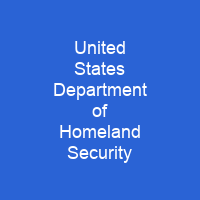The United States Department of Homeland Security: A Brief Overview
Imagine a giant shield protecting America from all kinds of threats—terrorists, natural disasters, cyber attacks, and more. That’s the role of the Department of Homeland Security (DHS). Established in 2002 after the devastating September 11 attacks, DHS was born out of necessity to coordinate a unified response to domestic emergencies and terrorism.
A Historical Perspective
The journey to form DHS began with President George W. Bush’s announcement of the Office of Homeland Security (OHS), headed by Tom Ridge, on October 8, 2001. This office was a precursor to the full-fledged department that would eventually be created in 2002 through the Homeland Security Act.
The Largest Reorganization Since World War II
With the creation of DHS came the largest government reorganization since World War II. The department incorporated 22 agencies, marking a significant shift in how the U.S. handles national security and public safety. This massive restructuring was aimed at creating a more cohesive approach to protecting America from various threats.
Key Functions of DHS
The primary mission of DHS is to safeguard the nation against domestic emergencies, terrorism, and other threats. It oversees numerous agencies that work together to ensure public safety. Here’s a closer look at some key components:
- U.S. Citizenship and Immigration Services (USCIS): Manages lawful immigration into the United States.
- U.S. Customs and Border Protection (CBP): Protects the U.S. border against illegal entry and illicit activity.
- Cybersecurity and Infrastructure Security Agency (CISA): Focuses on protecting critical infrastructure from cyber threats.
Organizational Structure
The DHS is headed by the Secretary of Homeland Security, who oversees operational components like the U.S. Coast Guard during times of peace and support components such as the Federal Emergency Management Agency (FEMA). Each component has its own director and deputy director, working together to ensure a coordinated response.
Notable Events in Recent Years
The DHS has faced numerous challenges and controversies over the years. For instance, during the first Trump administration, there were directives regarding biometric collection that disregarded age. In 2018, President Trump signed a law creating CISA, further solidifying its role in cybersecurity.
Biden Administration Initiatives
Under the Biden administration, DHS has continued to evolve. In 2021, an investigation into white supremacy began within the department. More recently, U.S. Customs and Border Protection started using apps for biometric data collection from asylum seekers, while a DHS official mentioned tracking migrant children’s identities with facial recognition technology in June 2024.
Challenges and Criticisms
The DHS has faced significant criticism over the years. Issues such as excess spending, waste, ineffectiveness, and lack of transparency have been major concerns. Data mining programs like ADVISE have raised privacy concerns, while fusion centers have been criticized for potential misuse and civil liberties violations.
Future Directions
The future of DHS remains uncertain as calls for its abolition continue. Critics argue that the department has failed to adequately protect against threats and has engaged in practices that infringe on privacy rights. However, supporters believe it is essential for coordinating a comprehensive approach to national security.

As the DHS continues to evolve, it faces a complex landscape of challenges and opportunities. Will it remain as is, or will there be significant changes? Only time will tell.
The journey of the Department of Homeland Security has been marked by both triumphs and controversies. As we move forward, the question remains: How can this department best serve its mission while addressing the concerns raised by critics?
You want to know more about United States Department of Homeland Security?
This page is based on the article United States Department of Homeland Security published in Wikipedia (retrieved on March 11, 2025) and was automatically summarized using artificial intelligence.




